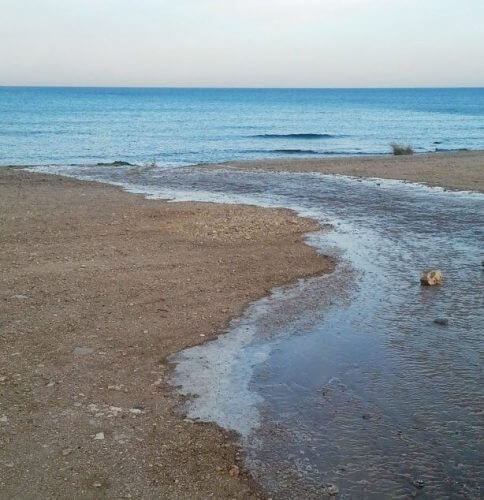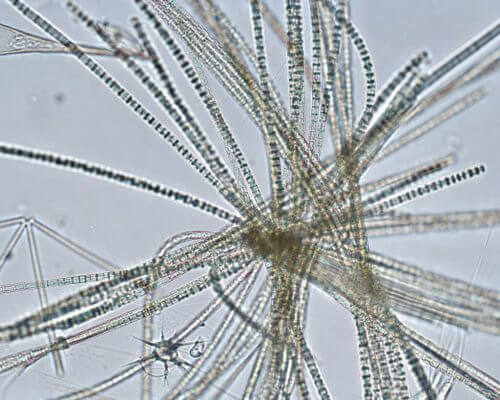A sewage leak into the sea in Haifa caused the bloom of rare bacteria and an impact on the marine ecosystem - and is a warning sign against such leaks, which occur every year in the winter

By Racheli Vox, Angle, Science and Environment News Agency
The following story begins entirely by chance. "One morning in February 2015, I looked out of the window of my office in Haifa, which is located right above the sea, and suddenly I saw a spot in the water, close to the shore, around a municipal pipe," says Dr. Eyal Rahab, a researcher at the National Institute of Oceanography in the Research of Seas and Lakes in Israel. "I realized right away that it was probably a sewage stain, and I decided to go and check the matter.
"In hindsight it turned out that it was a serious malfunction in the municipal sewage system that lasted for five days, during which sewage simply spilled into the sea. The stain was located very close to the station where we regularly sample the seawater, so it was a unique opportunity to see what happens when they have an external effect of sewage."
And so, a seemingly "routine" sewage leak turned into an opportunity that ended in groundbreaking research - which discovered rare bacteria in the Mediterranean Sea and changes in the ecosystem. The study, which Rahav conducted with Dr. Ido Bar-Zev, a researcher at the Water Research Institute at the Midrash Sade Boker campus of Ben Gurion University, Recently published In the journal Scientific Reports.
The bacteria flourish in the sea
The winter season and the coming welcome rains are characterized by many infrastructure failures, which in many cases cause infections in the sea. Last winter, for example, Declared bathing beaches in Israel were closed for a total of 310 days Due to contamination warnings. The main reason for the increase in the number of sewer failures in the winter is The existence of connections between the drainage systems and the sewage systems, which cause large amounts of water to flow from the drainage systems, especially on rainy days when there is a load on these systems, into the sewage systems. Thus, in many cases the sewage system is flooded and clogged, and sewage leaks out. In addition, on days like these, the wastewater treatment facilities are suddenly forced to deal with volumes of wastewater that are much greater than their capacity, which often leads to the discharge of wastewater into the sea.
Beyond the health danger of sea pollution and the odor hazards, which necessitate the closing of beaches, sewage water is rich in various substances that are nutrients for marine creatures, such as algae. Therefore, discharge of sewage into the sea may cause a rapid increase in the amount of algae - which may lead to a change in the existing equilibrium between the marine animals, and hence ultimately to damage to the ecosystem, which may be far-reaching and lasting.
The main and unexpected phenomenon found in the study is the appearance of a large amount of bacteria of the Trichodesmium type, which are usually very rare in the Israeli Mediterranean Sea. The phenomenon, known as a "bloom" of Trichodesmium, has never been observed on the Israeli Mediterranean coast. Beyond that, the extensive bacterial bloom also led to a massive appearance of algae that is hardly observed in the area - and actually caused the construction of a food chain that relies on the products of the bacteria that appeared due to the spill.

"If there is ready food, then there is no reason to start cooking"
Trichodesmium is a type of cyanobacteria (cyanobacteria) - bacteria that are found in bodies of water, and may be familiar to some of you from the Kinneret, where they occasionally appear in the form of a brown layer that covers large areas of water.
Cyanobacteria are special in that some of them are able to use nitrogen gas, which makes up about 78 percent of the gases in the Earth's atmosphere. Atmospheric nitrogen is found in a form that is not available for use by most living organisms, while Trichodesmium is able to break it down into a form of nitrogen that other living things, such as algae and other bacteria, can use.
Blooms of Trichodesmium are observed in Israel in the Red Sea, and there is even a belief that they are the ones who gave the sea its name. In blooms of the bacterium in the Atlantic Ocean You can even watch from satellites. But as mentioned, they are usually almost impossible to find in the Mediterranean Sea in Israel. "We searched for them for ten years", says Rahav, "sometimes we would filter a thousand liters of sea water and find nothing".
The researchers hypothesize that two main factors helped the cyanobacteria to flourish so quickly and so impressively. First, the sea was very calm during the five days of the sewage leak, the water temperature was relatively high and almost no wind was observed in the area - optimal conditions for the development of trichodesmium. In addition, the researchers believe that the sewage that was poured into the sea contained a high concentration of carbon, which is one of the substances that Trichodesmium needs in its diet. Normally, cyanobacteria obtain carbon by fixing carbon dioxide through photosynthesis, but according to the researchers, the sewage that arrived was rich in organic carbon, meaning carbon that had already gone through the process of photosynthesis and turned from inorganic material into organic material. The researchers believe that Trichodesmium is able to consume organic carbon directly, and not just through photosynthesis, and this is also easier for it. "If there is already prepared food, then they have no reason to start cooking," says Rahab.
Apart from the immediate effect of the Trichodesmium bloom, the significant increase in available nitrogen caused a 4-fold increase in the frequency of algae from the diatom class (formans) and a 7-fold increase in the frequency of algae from the dinoflagellate class in the spill area. "We saw the food chain getting built," says Rahav. "The nitrogen fixation by Trichodesmium stimulated the entire microbial system - bacteria, algae, etc. - and very quickly."
Not a decree from heaven
The beach in Haifa is not the only one whose microbiological system has recently undergone a sudden upheaval due to unexpected blooms. "Sewage also comes from Gaza and affects the entire length of the coast, this is something that can be seen from satellites," says Rahab. A widespread bloom of cyanobacteria in Florida Last year caused the closure of many beaches in the south of the country due to the great stench and the health hazard they caused.
Recently, Trichodesmium has made headlines due to its massive bloom in the Canary Islands, which are visited by over 12 million tourists a year. The rash, which mainly affected Tenerife, the largest and most populated island in the archipelago, caused the closure of several beaches for bathing, including the popular Teresitas beach. The water on the infected beaches was colored greenish-brown due to the rash and tourists who bathed in it later suffered from skin irritations due to the toxins that the trichodemium releases into its environment.
Such blooms do not only harm bathers or tourists - they may also complicate the seawater desalination process, because filtering the cyanobacteria from the water causes the desalination process to consume more energy, which may cause operational problems.
In conclusion, Rahav emphasizes that booms like the one that occurred in Haifa are not a decree from heaven. "The sewage flowing from the south is admittedly not under our control, and of course there are also natural processes that can cause such eruptions, such as dust storms, but a municipal fault like this that put sewage into the sea for five days is something that can be prevented. We need to prevent the entry of human-made external pollutants into our water."

2 תגובות
This is not a fault in the sewage system - it is a policy - to pour sewage along with the flood water, to lower the level of the sewage reservoirs - they are used for irrigation in the summer, and in the winter they have no solution!
A question is how long does it take for the ecosystem to return to a natural state after such pollution, if within five days a new ecosystem is created